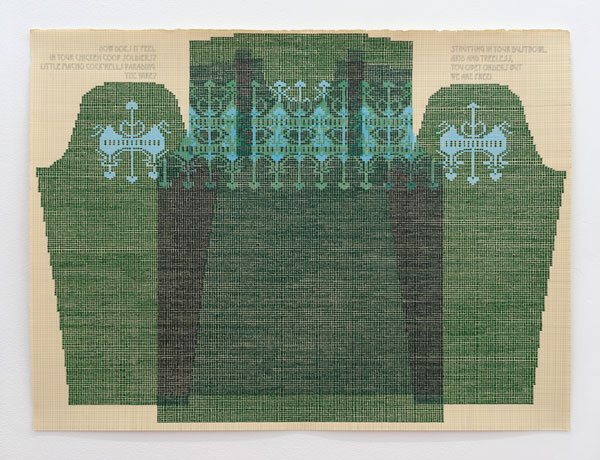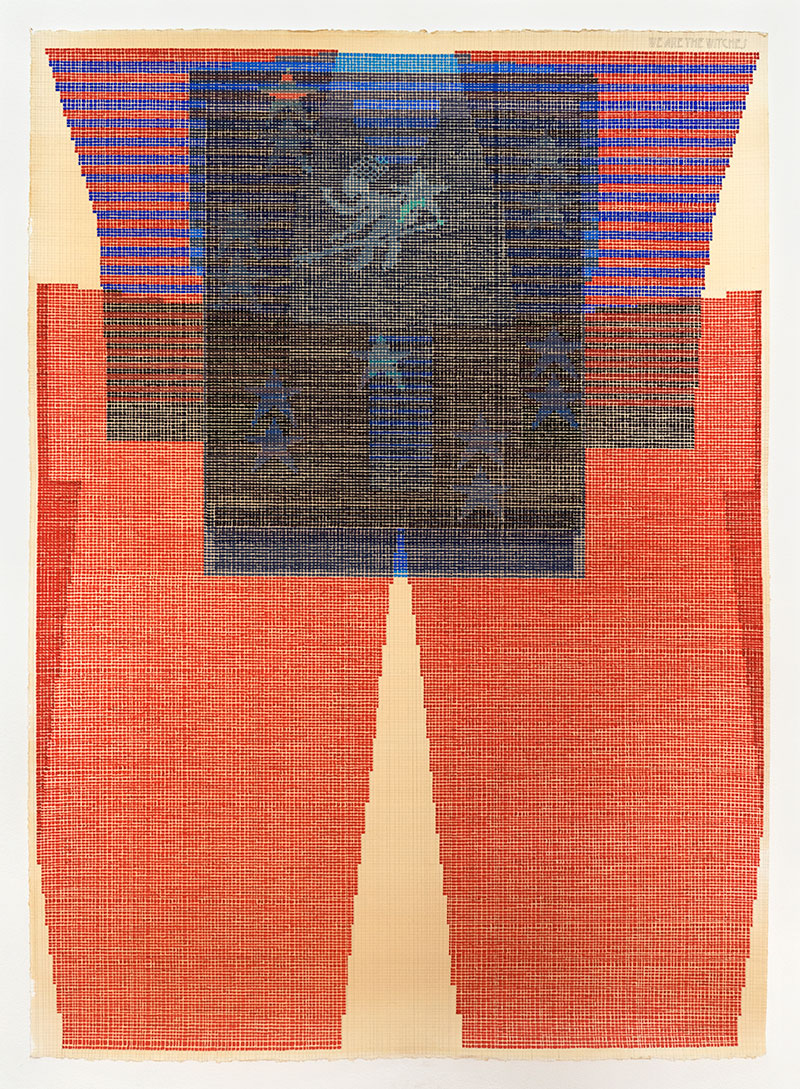Ellen Lesperance has never trod lightly when imparting the social and political beliefs, inspirations and intentions guiding her practice. Raised in Seattle and based in Portland, Lesperance has been consistently straightforward in pointing to her feminist mother and growing up in a mixed-race family as factors in steering her interests towards feminism and sociopolitical activism, the latter having to do with the ethics and strategies of “creative direct action.” So informed, technically, Lesperance’s practice employs Symbolcraft, a grid-oriented traditional means of communication inherent to and utilizing the practice of knitting by way of meticulous painting because, the artist claims, knitting is historically women’s work, not beholden to a patriarchal tradition of practice. Among her stated aims is the desire to rescue any aspect of female activists, including clothing, which may otherwise be lost to the selective tendencies of official histories.
For “Lily of the Arc Lights,” her first solo exhibition in New York City, Lesperance continues to make use of Symbolcraft in interpreting, memorializing and activating the agency of the individuals and artifacts of feminism and activism. In this instance, Lesperance narrows her scope towards the particular yet vast subject of Greenham Common—the former a territory in Berkshire, England, with a lengthy, contested history—and its women’s peace camps, the latter’s response revealing what makes that history worthy of attention. In fact, that history spans centuries, alternating between popular and wartime uses, as determined by respective governments. In 1980, during the Cold War, the territory came to house the largest stockpile of nuclear missiles in Europe. The following year, women’s peace camps surrounded its perimeter, setting the stage for nearly 20 years of remarkably creative protests.

Ellen Lesperance, How Does It Feel in Your Chicken Coop, Soldiers? Little Macho Cockrells Parading the Wire? Strutting in Your Dustbowl, Arid and Treeless, You Obey Orders but We Are Free! (2018), courtesy Derek Eller Gallery, photo by Robert Wedemeyer.
“Lily of the Arc Lights” consists of 10 new paintings of gouache and graphite on tea-stained paper, one accompanied by its sweater realization. Not only do the paintings evoke an earthy, painstaking process in interpreting memory and recorded media, they contain hollowed-out Desdemona-font texts, such as the colorful, graded and abstracted As If The Earth Itself Was Ours By New Covenant (all works 2018). We Are The Witches reflects a child-like motif of a witch riding her broomstick in the nighttime sky, surrounded by large, crooked stars, cloaked in blues above reds. Stay Safe contains those very words in its grid-like patterns, along with images of a peace dove, a peace sign, and a blazing rocket, with monochrome abstract shapes surrounding. Shall There be womanly times? Or Shall We Die? posits its question through imagery of mountainous landscape under starry sky in blues and browns, and Fireworks displays beautiful, folksy, colorful arrangements of rings.
In making Greenham Common and its women’s peace camps her subject, Lesperance invokes the lives of ordinary people, and larger structures and entities of power at play in the world as real contingents, interpreted and sharpened by a process of work bound to feminist and activist perspective. In a clever stroke, we may access this all through the sweater, materialized, inviting us into the exhibition.


